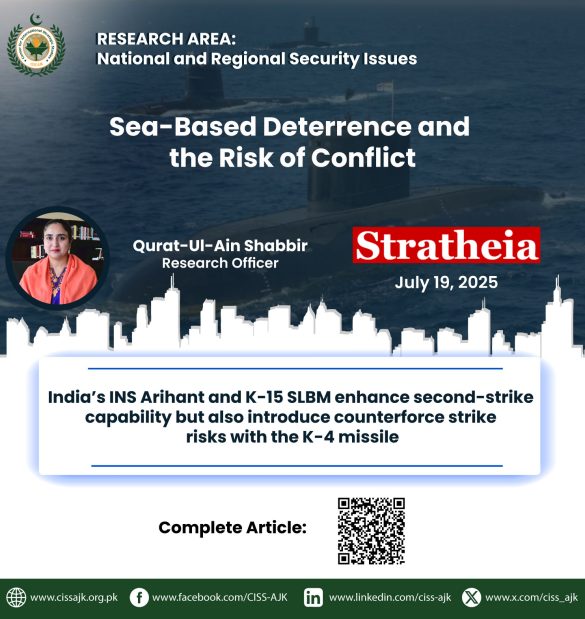As the world has already seen what future conflict in the South Asian region could be like, either through the tussle over the mountainous territory of Kashmir or through a military standoff on the land boundaries. However, another potential flashpoint is lurking in the shadows. South Asia, specifically, and the Indian Ocean in general, is being drawn into a dangerous future by the rapid nuclearization of the Indian Navy.
India’s sea-based nuclear deterrent’s ambiguity increases risks of accidental escalation and miscalculation in South Asia.
Its doctrinal gray areas, doctrines, and counterforce inducements are at the heart of its emerging nuclear strategy. Given that New Delhi continues to improve its sea-based deterrent, there are increasing risks of miscalculation, unintended destabilization, and doctrinal erosion not only for Pakistan but also for the international nuclear order and security.
At first, the world took India’s maritime nuclear project as a balancing act meant to gain a second-strike capability, which was made plausible with subs like INS Arihant and INS Arighaat. Nevertheless, lately, there have been some indications that New Delhi is drifting towards a strictly punitive course. With the K-15 SLBM mounted on the Arihant, India can target Pakistan from the Arabian Sea, making this capability far more relevant to the India-Pakistan strategic equation than to that of India-China. However, the most pressing concern is the K-4 missile, a long-range SLBM whose inaccuracy, according to Indian officials, is virtually zero. This matters little when it comes to a retaliatory attack, but its significance is tied to its first-strike counterforce capability.
Furthermore, India is currently testing a submarine-launched variant of the BrahMos cruise missile, a system often described in Indian media and military circles as having nuclear delivery capability. Even if it is not presently armed with a nuclear warhead, such ambiguity remains dangerous. Conventional BrahMos launching by a naval platform during a crisis would be misinterpreted as a nuclear action-causing accidental escalation.
This kind of doctrinal obscurity is not unique. It could be beneficial for establishing or maintaining deterrence, but sea-based nuclear ambiguity is much riskier. In the sea environment, enemies have no time for observation to differentiate between nuclear and non-nuclear units. This combination of dual-usage submarine weapon systems and the absence of obvious red lines can turn the South Asia oceanic environment into a space where even small events may quickly deteriorate into fulminating strategic failures.
Lack of transparent command and control over nuclear submarines threatens regional security and crisis management.
Another major cause of concern here is that the sea-based nuclear deterrence that India is trying to establish is without transparent command and control. The naval platforms are not tightly controlled and monitored. Moreover, verification in such a naval platform is hard in real-time compared to land-based systems, where the communication is centralized. The strategic resources of India are being deployed in an environment where it’s quite difficult to supervise or administer them, and launch authorization may prove to be dangerously decentralized, especially in the event of a high-intensity crisis.
To make matters worse, India persists in characterizing its sea-based deterrent to target China, yet almost all its deployments and tests keep Pakistan within its weapons range. This drift creates apprehensions in Islamabad of an Indian trend towards a counterforce posture of a disarming first strike. Pakistan, in turn, might reciprocate by obfuscating its nuclear-conventional divides, which can be witnessed in its reported plans to equip diesel-electric submarines with the Babur-3 cruise missile. This leads to a potentially deadly arms race underwater, with neither party confident about the intentions or capabilities of the other.
Yet it is not just a bilateral problem. The Indian Ocean is one of the most heavily traveled bodies of water in the world, with conflicting territorial claims, great power positioning, and sensitive trade routes. The addition of nuclear, possibly nuclear-armed, Indian platforms to this environment poses the risk of accidents with worldwide impact. A false alarm missile launch or the sinking of a submarine mistakenly assumed to be one of their nuclear assets might draw in foreign powers such as China, the U.S., or others into an unwanted crisis.
India’s naval nuclear deployments primarily target Pakistan, fueling fears of a disarming first strike and underwater arms race.
India has been wary of participating in nuclear risk reduction mechanisms, especially those centered on the naval sphere. The Indian-Pakistani military hotline is poorly utilized. Due to diplomatic impasses, the proposed bilateral “Incidents at Sea Agreement,” initially suggested during the 1999 Lahore Declaration, has yet to be finalized. And even as India enlarges its nuclear stockpile, it provides minimal transparency on doctrine, force posture, or even the chain of command over its sea-based nuclear weapons.
If India genuinely seeks to project itself as a responsible nuclear power and an advocate of a “rules-based maritime order,” it must lead by example, not plunge the region into deeper opacity and brinkmanship. This includes:
- Publicly clarifying the nuclear or conventional nature of platforms like the BrahMos and other SLBMs.
- Institutionalizing crisis communication mechanisms at the naval level.
- Separating nuclear-capable vessels from conventional fleets and placing them under clear civilian and strategic command.
- Reinvigorating regional maritime CBMs through platforms like the Indian Ocean Naval Symposium and SCO security dialogues.
Regional cooperation and crisis communication mechanisms are essential to prevent nuclear accidents and escalation in the Indian Ocean.
Ultimately, global nuclear stability cannot afford a silent front opening up beneath the waves of South Asia. The consequences of India’s current trajectory are not confined to New Delhi or Islamabad. They are ripples that could become tidal waves in a crisis. Strategic ambiguity may have its place, but in the submarine shadows of the Indian Ocean, clarity is the only path to security.
Disclaimer: The opinions expressed in this article are solely those of the author. They do not represent the views, beliefs, or policies of the Stratheia.



